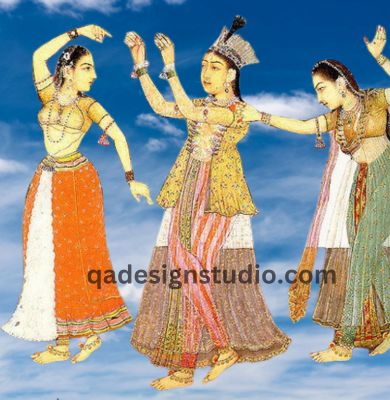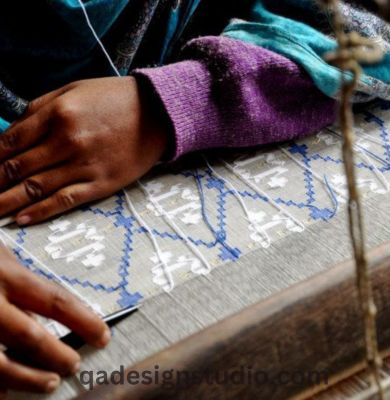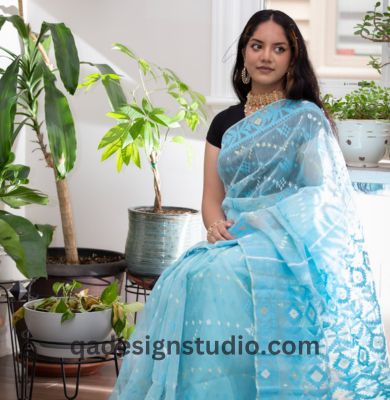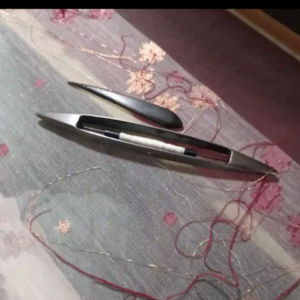Jamdani Silk Sarees have been an integral part of Bangladeshi culture for centuries and are among the countless varieties of this traditional attire. The Jamdani silk saree stands out as a true masterpiece. Known for its intricate patterns, feather-light texture, and rich history. Jamdani silk saree is a symbol of timeless elegance and craftsmanship. In this article, we will delve into the world of Jamdani silk sarees, exploring their history, production process, unique features, and their enduring appeal.
I. Historical Legacy
The History of Jamdani sarees can be traced back to ancient Bengal. A region well known for its weaving traditions way. The name “Jamdani” itself has an interesting origin, as it is believed to be a combination of two Persian words – “Jam,” meaning flower, and “Dani,” meaning vase or container. This name aptly reflects the delicate floral motifs that are a hallmark of Jamdani sarees.
The history of Jamdani dates back to several centuries, with references to this exquisite art form found in ancient Sanskrit literature. It is believed that the origins of Jamdani weaving can be traced to the Mughal period, particularly during the reign of Emperor Akbar.The Mughals greatly appreciated the craftsmanship of the Bengali weavers and were patrons of this art. The Mughal influence is evident in the intricate designs and fine detailing that became characteristic of Jamdani sarees.

Throughout its history, the Jamdani saree has been associated with royalty and nobility. It was worn by queens, princesses, and aristocrats, adding to its aura of regal elegance. The saree’s luxurious silk fabric and exquisite motifs made it a symbol of prestige and opulence.
II. The Craftsmanship
Jamdani silk sarees are celebrated for their remarkable craftsmanship. The intricate motifs, often depicting flowers, leaves, and vines, are woven by skilled artisans entirely by hand. The distinctive quality of a Jamdani saree lies in the finesse of its weaving process, which is a labor-intensive and time-consuming art.
The Loom: The weaving of a Jamdani saree is done on a traditional pit loom. The weaver works with extreme precision and skill, interlacing the silk threads to create the intricate patterns. The loom is often set up in small villages and rural areas, keeping the tradition alive in its authentic form.

Muslin Threads: One of the defining characteristics of a Jamdani saree is the use of fine muslin threads, which are lightweight and delicate. These threads are often spun by hand, adding to the artisanal quality of the saree.
Brocade Weaving: The weaving technique used for Jamdani sarees is known as “brocade weaving.” This process involves creating small, decorative patterns by adding extra threads to the fabric during the weaving process. The motifs are seamlessly integrated into the saree, giving it a unique textured appearance.
Intricate Designs: The motifs on a Jamdani silk saree are often inspired by nature. You will find an array of floral, paisley, and geometric patterns woven into the fabric. These designs are created with meticulous attention to detail, and no two sarees are exactly alike.
III. Varieties of Jamdani Silk Sarees
Over the decades, various regions have adopted the art of Jamdani weaving, leading to the creation of distinct regional varieties. Some of the notable ones include:
Dhaka Jamdani: This is one of the most famous types of Jamdani sarees, with its origins in Dhaka, the capital of Bangladesh. Dhaka Jamdani sarees are known for their intricate patterns and the use of fine cotton and silk threads. These sarees often feature motifs of royal courts and Mughal architecture.
Shantipur Jamdani: Shantipur, a town in West Bengal, India, is renowned for its contribution to the world of Jamdani sarees. These sarees are characterized by their elegant simplicity and lightweight feel. They often feature intricate but understated motifs.
Dhonekhali Jamdani: Dhonekhali, another town in West Bengal, is known for its unique interpretation of Jamdani weaving. Dhonekhali Jamdani sarees are characterized by vibrant colors and bold motifs, making them a popular choice for festive occasions.

IV. Time-Tested Elegance
The resurgence of interest in handwoven textiles, sustainable fashion, and traditional craftsmanship has played a significant role in the modern popularity of Jamdani sarees. Many women appreciate the cultural and environmental significance of wearing a handwoven garment that supports local artisans and traditional techniques.
In recent years, fashion designers have also incorporated Jamdani fabrics into their collections, blending the classic beauty of these sarees with modern silhouettes and designs. This fusion has expanded the appeal of Jamdani sarees, making them a choice for both traditional and contemporary fashion enthusiasts.
VI. Caring for Jamdani Silk Sarees
To ensure the longevity of your Jamdani silk saree, it is essential to take proper care of it. Here are some tips on how to maintain the beauty of these exquisite garments:
Dry Cleaning: It is recommended to dry clean your Jamdani silk saree to protect it from any damage that can occur during the washing process.
Storage: Store your saree in a cool, dry


